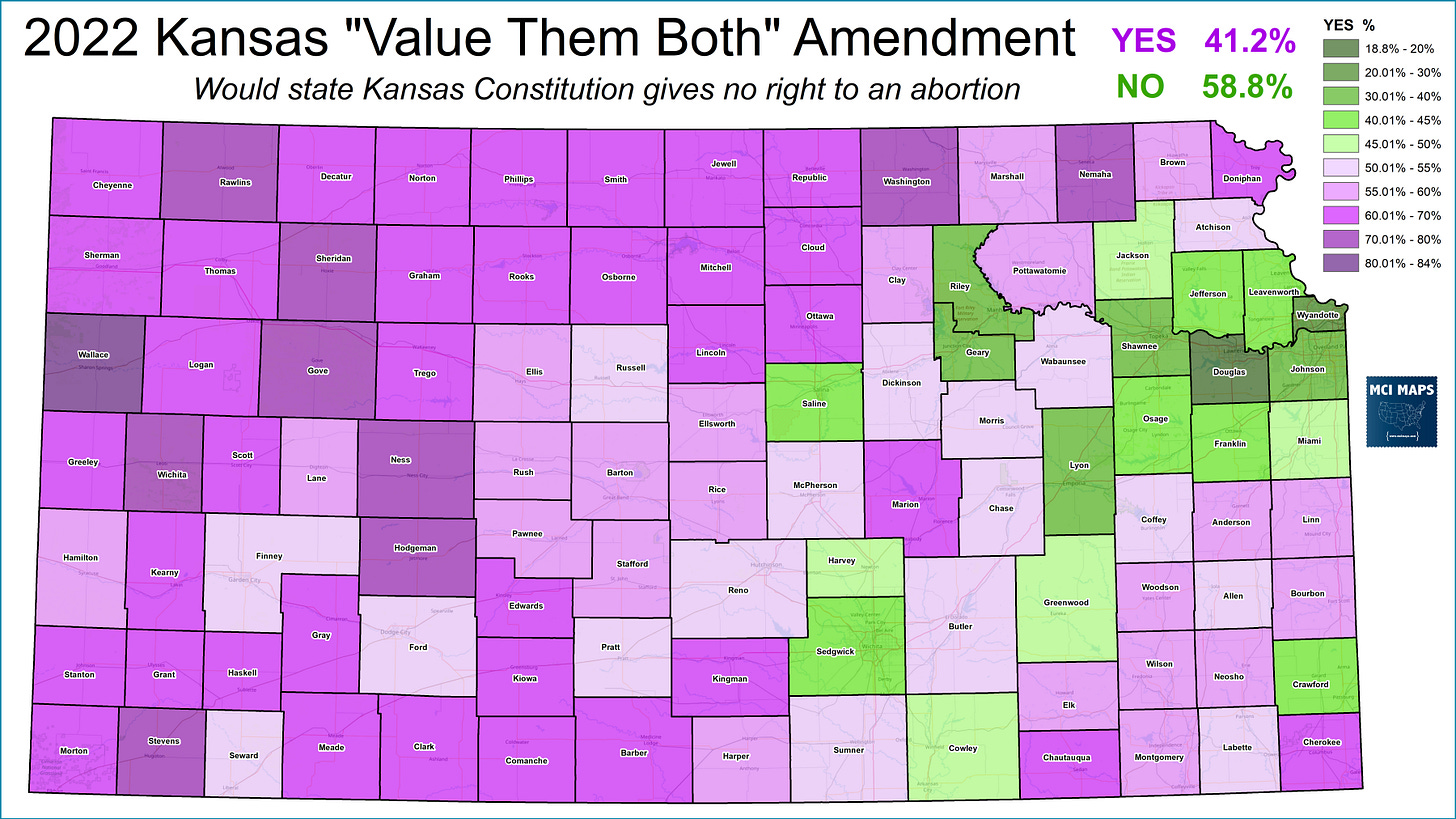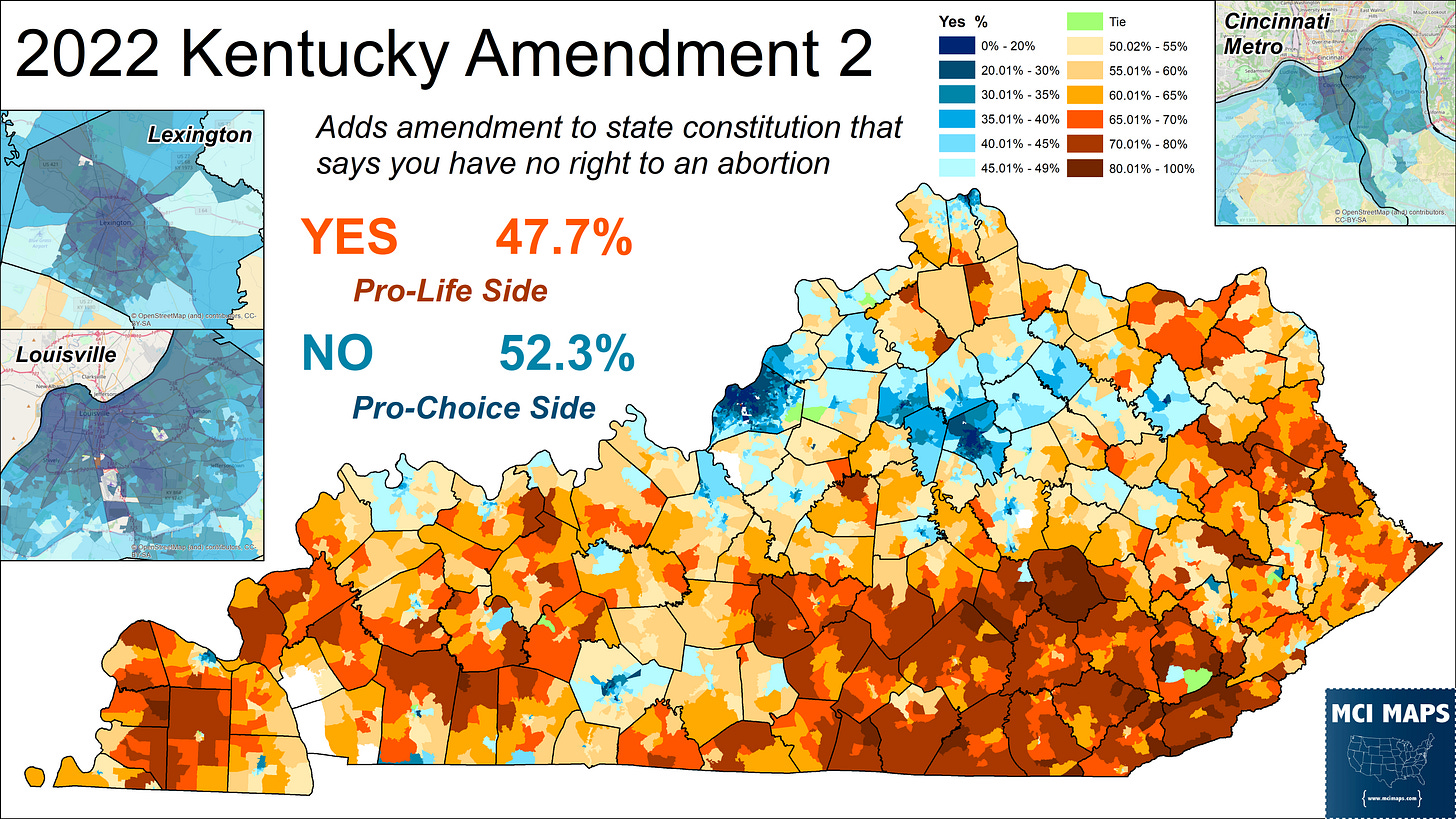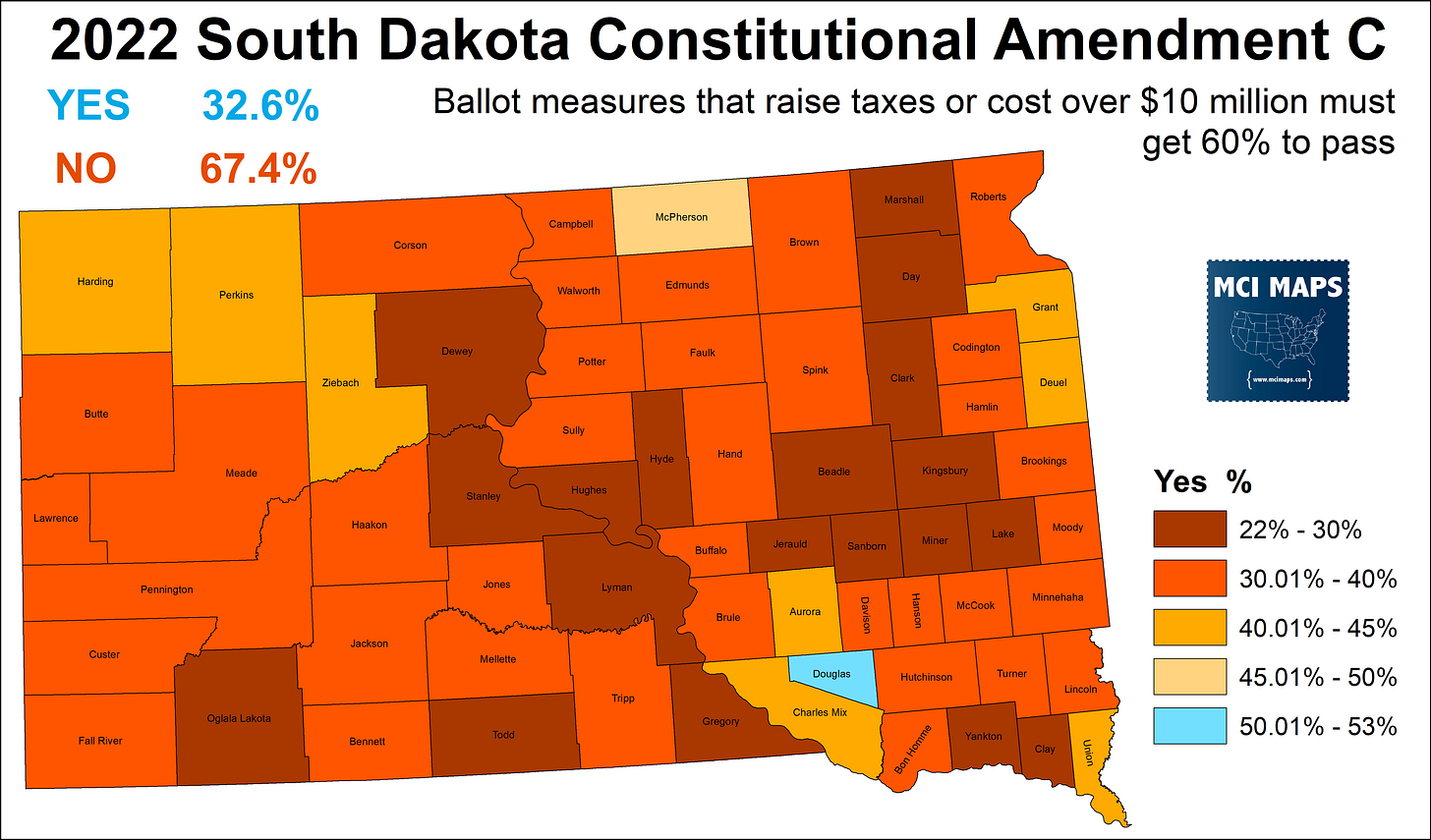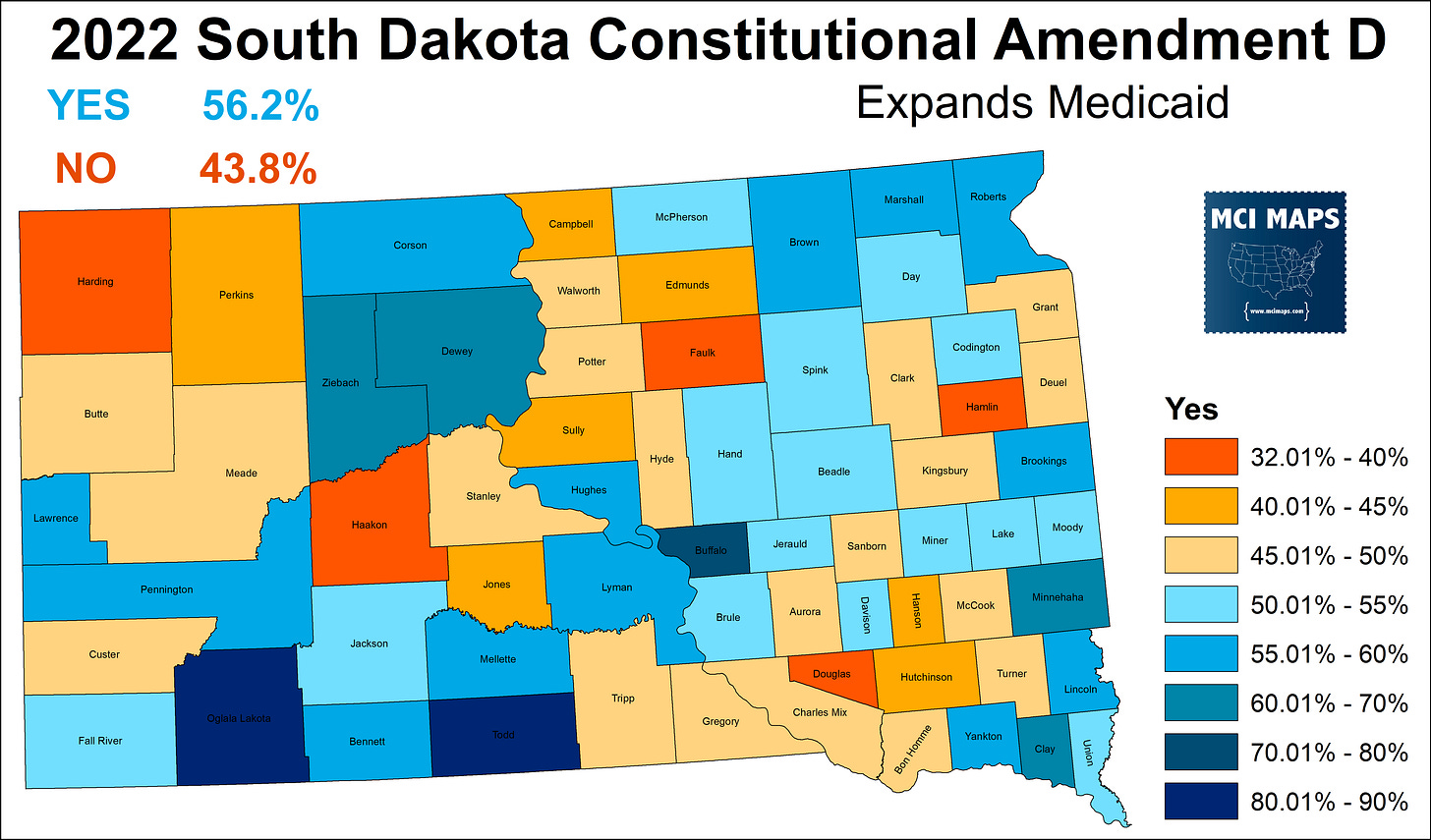Issue #121 - Ohio Issue 1 and the Politics around 60% for Ballot Measures
A right-wing power play in Ohio
Tomorrow, voters in Ohio will be casting ballots in a special election. The election is to cast ballots for Statewide Amendment 1 - which if passed would raise the passing threshold for ballot measures from 50% to 60%.
So why is this taking place? Because this November, voters will be casting ballots on a measure put forward by pro-choice groups that aim to codify abortion rights. As a result, pro-life groups are pushing a YES vote on Issue 1, while pro-choice groups are advocating a NO vote.
Since the repeal of Roe in 2022, the public has seen a notable turn toward pro-choice positions. Horror stories of rape victims being forced to travel, of women being arrested for using the abortion pill, and talks about also banning birth control, have led many soft pro-life voters to swing against the GOP on the issue.
This was first seen in the summer of 2022, when Kansas voters rejected a pro-life measure by a large margin. I wrote about that measure here.
Later that same year, Kentucky voters also rejected a similar pro-life measure. I wrote about that here.
With Ohio a fairly red state at this point, but not as red as Ohio or Kansas, the chances of the pro-choice side winning in Ohio seems very strong. The effort to move to a 60% threshold is a clear effort to short-circuit that measure.
This isn’t the first time the notion of raising thresholds for measures has come up. This is a topic that would come up in Political Science classes of mine back in 2005. In recent years, different states have voted on measures that raise thresholds for certain types of measures.
There is, in general, a legit debate point about direct democracy and if some measures should require broader consensus. That said, recent efforts in Ohio, Arkansas, and South Dakota to raise this threshold are clearly a right-wing power play. In light of this, I want to talk about some recent elections around this issue, while also discussing Florida’s path to mandating 60% back in 2006.
Recent Right-Wing Efforts
Last year, I wrote about the effort from Republicans in South Dakota to change their amendment threshold. In the summer of 2022, voters cast ballots on Amendment C, which would have raised the passing share to 60% if a measure would cost more than $10 million. This was entirely about stopping a Medicaid Expansion amendment that would be on the November ballot.
That measure failed.
Later that year, South Dakota voters would indeed vote to pass Medicaid. The measure got 56% of the vote, meaning had Amendment C passed, the measure would have failed.
Also last year, voters in Arkansas rejected a measure that would raise the threshold to 60%. This was also a right-wing measure from the GOP dominated legislature that did not want any ballot measures to override them. This measure failed with a fairly broad coalition.
The one state with an across-the-board 60% threshold is Florida. This is from a 2006 ballot measure. I wanted to talk about this, why it happened, and clear up some confusion on the topic.
Florida’s Move to 60%
Florida’s 2006 vote on raising the amendment threshold to 60% came after several years of debate. When I was in High School American Government classes in 2004, and FSU in 2005 (yes Gen Z followers, I’m that old) - the issue about Florida’s cluttered constitution was a major debate point. Florida does not have statute ballot measures, only constitutional.
Now, some states with statute measures, like Utah, carry a risk that the legislature will just override them. I covered that regarding several 2018 Utah ballot measures here. But with Florida, the concern was that controversial and niche issues were being added to the constitution of Florida itself.
Several measures raised ire, but a few stand out. One of the big debate points was the 2000 measure that mandated a high-speed train system for the state. This proposal would mandate high-speed or magnetic rail to link the major urban centers. Now don’t get me wrong, I think this is much needed, but what quickly emerged as an issue was the massive multi-billion dollar cost. As a result, voters passed a new measure in 2004 to repeal the effort.
When the measure passed, it was by a modest margin, something likely too close for such a massive expenditure that isn’t going to effect the life and well being of millions (like Medicaid expansion). The voters balked at this when the price tag became clear, with every county voting for the repeal. Its easy to see a more gradual expansion, a line from one city to the next, and then slowly expanding, would have had more success.
Another measure of notoriety was the infamous “Pregnant Pigs” Amendment 10 from 2002. This measure, pushed by animal rights groups, banned the caging or confining of pigs that were pregnant. No other animal was included, with only a broad declaration of rules. It passed by just under 10%, with strong opposition in the farm country.
Now before anyone thinks I’m ok with animal cruelty, the abuse that occurs, especially on factory farms, needs regulation and punishment. The federal government and state don’t do nearly enough. I’d have voted YES, but the debate point outside of the farm counties was the implementation and way the law would be locked into the constitution. This would be a great example of a statute-based amendment - but of course the risk there would be the legislature gets bought off and repeals it.
While the public broadly are anti-animal-cruelty, though they are great at turning their head when convenient, this served as another example of non-constitutional issues being added to the state’s core document.
Desiring to ensure that policy-based amendments only made it to the constitution with a broad public sentiment, Amendment 3 to raise the threshold to 60% was put on on the Florida ballot in 2006. It was put up by the legislature itself, and funded by several different industry groups - mostly those likely worried about whatever random policy-based amendment would show up that might upset their industry. In the Senate, most members voted to put it on the ballot. In the house, the vote was more partisan, with a large number of Democratic no’s.
When the measure was put before voters, it got 58%. It passed, ironically with less than 60%.
Now there is plenty of reason for liberals or democrats to be skeptical of the vote. Democrats in the house rejected the measure largely on the issue that this would of course aid the GOP. By 2006, Florida was not a strong red state, but the legislature had gerrymandered themselves well and redistricting reform was a possible ballot measure in the future. That said, many other Democrats knew they had the chance to win back the Governor’s office (ooops) and even a legislature if the lines were better. The politics of Florida in 2006 were not what they are now, so opposition or support for the measure were not a guarantee to benefit one side.
Many Democrats and lefties voted for the measure to stop right-wing measures the legislature might put up. I voted Yes in 2006 because I knew a same-sex marriage ban would likely be put before voters in 2008. Me and all my LGBT friends voted YES with the sole goal to stop that. Unfortunately, that measure got 62%. I wrote about that campaign here.
I am actually working on 2006 precinct maps, but won’t have anything for weeks/months as I get proper precinct borders set up. I did look through precinct returns and found that, broadly, left-wing precincts backed the 2006 measure. There is actually broad consensus in many counties, with little difference in support between demographics. In a few counties, there was more of a partisan divide, which likely reflects on the ground campaigns or local political leaders advocating.
Did Amendment 3 Hurt Liberals or Conservatives
After Amendment 3 passed, several measures have gone before the voters that are broadly left v right. For the sake of simplicity, I’m sticking with measures that got over 50%. The GOP legislature has put many right-wing bills on the ballot which fail to even secure 50%, so that isn’t at issue here.
So far, more conservative measures have been killed by this 60% rule than lefty measures.
Conservative measures that aimed to weaken education or renewable energy all failed thanks to the 60% rule. Same-sex marriage ban is their biggest win, while the citizen voting measure had broad support. And yes I voted NO on that because I think there is a very legit issue around allowing local residents with green cards to vote on things like city council or school board - especially when they have kids in the schools.
On the left side, several measures passed by the skin of their teeth, but broadly got past the 60% mark.
Fair Districts, who’s campaign I wrote about in my 2021 Florida Redistricting Preview Series, secured 63% of the vote.
The major left-wing loss was the 2014 ballot measure to legalize medical marijuana. This measure was originally broadly popular, but suffered from a fear-mongering campaign funded by deep pockets.
However, that loss would be rectified in two years, when the measure, made a bit more stringent on who could qualify for a card, easily passed with over 70% of the vote.
A 2018 measure that aimed to expand voting access for people convicted of non-violent felonies passed with 65% of the vote.
And in 2020, a minimum wage amendment got JUST over the 60% mark. This was by far the closest call.
So broadly, liberal ballot measures have managed to get past the 60% threshold. Meanwhile the conservative measures have come up short in a majority of instances.
This ratio would be put further to the test next November, as its very possible Florida may have legal weed and abortion rights on the ballot. A pro-choice measure is gathering petitions as we speak, while weed needs to get the FL Supreme Court to approve the ballot language (hopefully).
How to Vote on Ohio Issue 1
VOTE NO. Look I can/will defend the Florida requirement. I think its been a net positive for the left so far, and the circumstances around it were different. This effort in Ohio, like South Dakota, is a blatant partisan move aimed to stop a specific measure. It is so transparent. This type of effort should be rejected, and I would definitely be voting NO on this if I was in Ohio.
If Amendment 1 fails, then 50% will remain the threshold for the pro-choice measure in the fall. I foresee a pro-choice victory there. That will add nicely to my precinct map of abortion measures in West Virginia and Kentucky.
If you are in Ohio, Vote NO on Tuesday. And if you are not in Ohio then….















